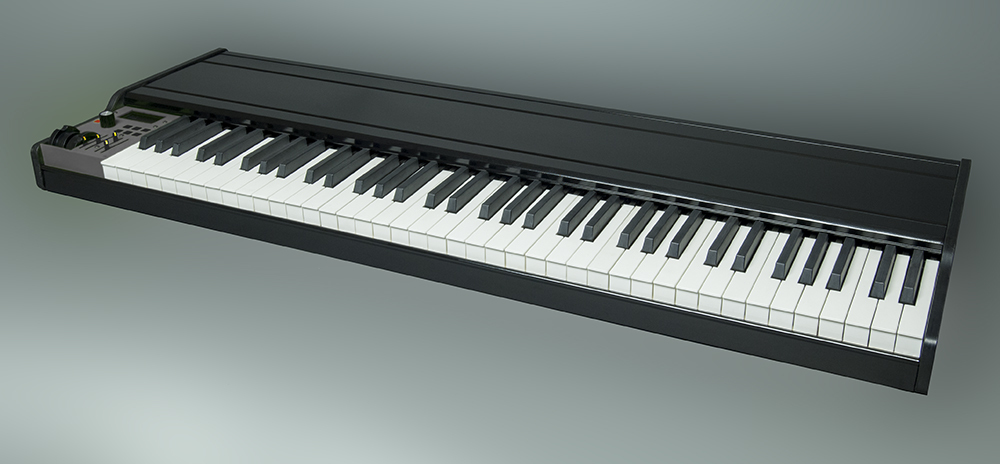My current one does not even have normal aftertouch.
So I am also wondering how that even works. That type of AT means that the aftertouch value is the same for all keys, right? How does the keyboard know which finger's force is to be used?
I highy doubt so... Even doubtful you can find a keyboard with Channel Pressure (non-poly aftertouch) implemented in that price range, but do prove me wrong!fluffy_little_something wrote:I was wondering whether there are any affordable Midi controller keyboards with polyphonic aftertouch and 61 keys.
Note of warning: I've been told by experienced keyboard players (of which I am not) that poly-aftertouch takes a lot of excersize to get under control. How's your keyboard playing technique currently?fluffy_little_something wrote:My current one does not even have normal aftertouch.
Each key has a pressure sensor ofcourse. That's why AfterTouch keyboards are so bloody expensive.fluffy_little_something wrote:So I am also wondering how that even works. That type of AT means that the aftertouch value is the same for all keys, right? How does the keyboard know which finger's force is to be used?
On electronic keyboards and synthesizers, pressure sensitivity is usually called aftertouch. The vast majority of such instruments use only channel aftertouch: that is, one level of pressure is reported across the entire keyboard, which affects either all notes pressed (even ones not being pushed into aftertouch) or a subset of the active notes in some instruments that allow this level of control. A minority of instruments have polyphonic aftertouch, in which each individual note has its own sensor for pressure that enables differing usage of aftertouch for different notes. Aftertouch sensors detect whether the musician is continuing to exert pressure after the initial strike of the key.
It does not. Possibly one pressure-sensitive strip is mounted on which all keys land. If there were individual sensors, it would technically already be poly-AT technology.fluffy_little_something wrote:how does the keyboard determine, which finger should determine the value which will be applied to all fingers?
^^^^This!jeamsler wrote:If you look used and are willing to use something that is more than just a controller and therefore comparatively heavy, there are some. The notable ones are the Ensoniq EPS, EPS16+ or ASR10 and the Ensoniq SQ80. Of these the original EPS would be the cheapest and if you just want it as a controller you can get it with no expansions for less than 250euro and even with some expansions for that price if you look around. The keybed can be cleaned (if needed) pretty easily if you don't mind a little disassembly. This is probably the cheapest way to go if you can put up with something bigger and heavier than a simple controller. I believe Keith McMillen Kboard and Qunexus are in your price range and you might be able to adapt to your needs. Not standard keys though and only 2 octaves. Not clear to me whether it can utilize polyphonic AT messages per se though. There is the Infinite Response VAX77 but that is way out of your price range. There are a few other older boards out there but likely way more expensive if you want them in good condition, and are heavier and/or harder to clean up than the EPS. I don't know of anything currently be manufactured with poly AT but look around; you never know.
The difficulty stems from the fact that the aftertouch mechanism can be very unresponsive, behaving almost like an on-off switch. This is also true of standard channel (monophonic) aftertouch designs. So I would say, this difficulty is based on the mechanics of the design rather than any special playing techniqe. As long as you can play some basic chords you can make use of poly-at and get good expression. Play a chord, articulate a gesture with one finger, second finger...it works well without having to be a virtuoso, provided the mechanism is 'tuned' well.BertKoor wrote:Note of warning: I've been told by experienced keyboard players (of which I am not) that poly-aftertouch takes a lot of excersize to get under control. How's your keyboard playing technique currently?fluffy_little_something wrote:My current one does not even have normal aftertouch.
Any chance of finding what you desire are almost nil if you take into account that the main key-bed manufacturer, Fatar, does not have a single design with poly-aftertouch. Remember, we live in the button-pushing era, not a keyboard-expression era, so there is little commercial push to make such designs available, even at a higher price point.fluffy_little_something wrote:I was wondering whether there are any affordable Midi controller keyboards with polyphonic aftertouch and 61 keys. There seem to be very few options, let alone affordable ones, by which I mean up to 250 euros or so. Are there any? I have not found anything on the sites of the big manufacturers so far.

© KVR Audio, Inc. 2000-2024
Submit: News, Plugins, Hosts & Apps | Advertise @ KVR | Developer Account | About KVR / Contact Us | Privacy Statement